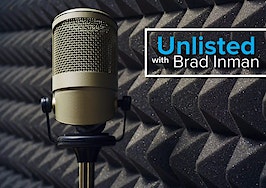- The share of agents (often teams) spending $5,000 a month grew 45 percent with their total dollar spend rising 57 percent.
- Zillow Group released bullish results for Q3 today after the markets closed.
- The company generated $176.8 million in top-line revenue for the third quarter and had an adjusted EBITDA of $29.5 million.
Zillow Group may have stumbled in the first part of the year with problems meeting Wall Street’s expectations and its own forecast, but the Seattle company seems to have turned the corner, releasing bullish third-quarter results today after the markets closed.
“Super agents” — often teams — who spend $60,000 a year on the Zillow platform are driving the company’s revenue growth and are now the focus of company resources. CEO Spencer Rascoff said these super agents are often teams who respond better and faster to leads, increasing their ROI (return on investment).
“There is a significant change underway in the real estate industry which Zillow Group is accelerating, and that is a shift from the part-time agent who dabbles and is a hobbyist” to the tech-savvy real estate team leader, Rascoff said in an investor call.
The company reported adjusted Q3 earnings of 7 cents a share on revenue of $176.8 million. It had an adjusted EBITDA (earnings before interest, taxes, depreciations and amortizations) of $29.5 million. It beat consensus analyst estimates for top-line revenue ($176.5 million) and crushed the $19.2 million estimate for adjusted EBITDA.
Cost-cutting after the Trulia acquisition and lower advertising costs were two drivers of higher EBITDA numbers.
Zillow Group completed its integration of Trulia in August, months ahead of schedule, and said it had created “headcount efficiencies” across its sales and marketing, and technology and development divisions along the way.
Now that the transition is over, the company can refocus its energy on overall revenue growth of the business, Zillow Group chief financial officer Kathleen Philips told investors.
The company expects its 2016 revenue growth to exceed this year’s growth. Zillow Group will be investing in the short- and long-term growth of its audience as well as “transaction innovation,” among other items, according to Philips.
After the Zillow-Trulia consolidation, “we are more in control of our destiny now than ever before,” Rascoff said.
Zillow Group posted a net loss of $26 million in Q3, up from $16 million the same period a year ago. In the first nine months of this year, the company suffered a net loss of $123 million compared to $32.7 million at the same time a year ago.
The summary released today: Revenue of $176.8 million, up 13 percent year-over-year on pro forma basis, in line with the company’s outlook.
- Marketplace revenue of $153.2 million, up 22 percent year-over-year on pro forma basis
- Real estate revenue of $129.7 million, up 27 percent year-over-year on a pro forma basis
- Mortgages revenue of $12.6 million, up 60 percent year-over-year on a pro forma basis
Growing agent ‘wallet share’
Much of the company’s growth is coming from top-spending Zillow customers who are often “teams and firms building their business around Zillow,” according to Rascoff.
The company pointed to a 45-percent growth rate in Premier customers spending $5,000 or more per month and a 57-percent jump in the total ad spend of these high-spending agents.
The company has grown its leads to Premier Agents 36 percent year over year, he said.
The company’s average monthly revenue per advertiser, or ARPA, was $402 in the third quarter, up 20 percent from $334 in Q3 2014.
“The increase in ARPA was primarily driven by high-performing agents buying more advertising inventory from us rather than by increasing the price for existing advertising inventory,” the company said.
Zillow Group agent advertisers, known as “Premier Agents,” stood at 96,965 at the end of September. That figure is down from nearly 102,000 in the second quarter and from over 103,000 in the first quarter.
Those quarterly decreases were “intentional” and “desired,” Rascoff said. The company’s sales team is focused on growing Premier Agent revenue, not total advertiser count, he added.
“We have many, many leads and we need them to go to great agents who will convert them to commission checks at a 5, 10, 15 percent conversion rate,” Rascoff said.
The company intends to actively grow its agent teams and high-spending agents while discouraging low-spending agents from renewing their ad subscriptions, according to Philips.
Zillow Group is placing impressions — which will continue to grow as the company’s traffic grows — in the hands of “industrious high ARPA advertisers,” she said.
“Churn in this cohort continues to be minimal. Our lowest spending agents had the highest rate of churn,” she added.
This is why the company has been offering up tools to make these big-spenders more efficient, she said, including its acquisition of dotloop and launch of its Premier Agent app.
The company wants to grow “wallet share” of agents’ total ad spend, according to Rascoff.
He estimated that Zillow Group is responsible for perhaps 5 percent of commission checks, which “still feels very early relative to what it can get to,” he said.
He pointed to trends favorable to the company: agents becoming more educated about handling online leads, less tech-savvy agents leaving the industry, more agents using a combination of a team approach and software to convert leads, and more and more agents using a CRM (customer relationship management platform) and importing Zillow Group leads through the company’s Tech Connect program.
After markets closed when it released its results, Zillow Group shares advanced 3.3 percent to $30.48 but then later fell 7.6 percent during the investor call.
| Analyst Consensus Estimates* | ||
| 3Q15 | Zillow Group | FirstCall |
| Total Revenue | $176.8 mil | $176.5 mil |
| Adjusted EBITDA | $29.5 mil | $19.2 mil |
| Non-GAAP net income per share (diluted) | $0.07 | ($0.03) |
Editor’s note: This story has been updated. The story has also been corrected to note that the share of agents spending $5,000 or more on Premier Agent advertising in the third quarter rose 45 percent, not 57 percent. Such agents’ dollar spend rose 57 percent in Q3.








